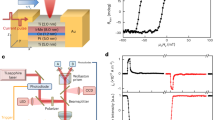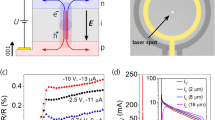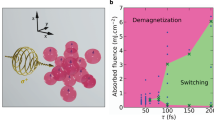Abstract
The development of approaches that can efficiently control the magnetization of magnetic materials is central to the creation of fast and low-power spintronic devices. Spin transfer torque can be used to electrically manipulate magnetic order in devices, but is typically limited to nanosecond timescales. Alternatively, spin–orbit torque can be employed, and switching with current pulses down to ~200 ps has been demonstrated. However, the upper limit to magnetization switching speed remains unestablished. Here, we show that photoconductive switches can be used to apply 6-ps-wide electrical pulses and deterministically switch the out-of-plane magnetization of a common thin cobalt film via spin–orbit torque. We probe the ultrafast magnetization dynamics due to spin–orbit torques with sub-picosecond resolution using the time-resolved magneto-optical Kerr effect (MOKE). We also estimate that the magnetization switching consumes less than 50 pJ in micrometre-sized devices.
This is a preview of subscription content, access via your institution
Access options
Access Nature and 54 other Nature Portfolio journals
Get Nature+, our best-value online-access subscription
$29.99 / 30 days
cancel any time
Subscribe to this journal
Receive 12 digital issues and online access to articles
$119.00 per year
only $9.92 per issue
Buy this article
- Purchase on Springer Link
- Instant access to full article PDF
Prices may be subject to local taxes which are calculated during checkout




Similar content being viewed by others
Data availability
The data that support the plots within this paper and other findings of this study are available from the corresponding author upon reasonable request.
Code availability
The code that reproduced the fits within this paper is available from the corresponding author upon reasonable request.
References
Liu, Y. & Yu, G. MRAM gets closer to the core. Nat. Electron. 2, 555–556 (2019).
Radu, I. et al. Transient ferromagnetic-like state mediating ultrafast reversal of antiferromagnetically coupled spins. Nature 472, 205–208 (2011).
Stupakiewicz, A., Szerenos, K., Afanasiev, D., Kirilyuk, A. & Kimel, A. V. Ultrafast nonthermal photo-magnetic recording in a transparent medium. Nature 542, 71–74 (2017).
Kirilyuk, A., Kimel, A. V. & Rasing, T. Ultrafast optical manipulation of magnetic order. Rev. Mod. Phys. 82, 2731–2784 (2010).
Olejník, K. et al. Terahertz electrical writing speed in an antiferromagnetic memory. Sci. Adv. 4, eaar3566 (2018).
Manchon, A. et al. Current-induced spin–orbit torques in ferromagnetic and antiferromagnetic systems. Rev. Mod. Phys. 91, 035004 (2019).
Dieny, B. & Chshiev, M. Perpendicular magnetic anisotropy at transition metal/oxide interfaces and applications. Rev. Mod. Phys. 89, 025008 (2017).
Kent, A. D., Özyilmaz, B. & Del Barco, E. Spin–transfer-induced precessional magnetization reversal. Appl. Phys. Lett. 84, 3897–3899 (2004).
Lee, O. J., Ralph, D. C. & Buhrman, R. A. Spin–torque-driven ballistic precessional switching with 50-ps impulses. Appl. Phys. Lett. 99, 10–13 (2011).
Stiles, M. & Zangwill, A. Anatomy of spin–transfer torque. Phys. Rev. B 66, 014407 (2002).
Sato, H. et al. 14-ns write speed 128-Mb density embedded STT-MRAM with endurance > 1010 and 10 yrs retention @ 85 °C using novel low damage MTJ integration process. In 2018 IEEE International Electron Devices Meeting (IEDM) 27.2.1–27.2.4 (IEEE, 2018).
Garello, K. et al. Ultrafast magnetization switching by spin–orbit torques. Appl. Phys. Lett. 105, 212402 (2014).
Miron, I. M. et al. Perpendicular switching of a single ferromagnetic layer induced by in-plane current injection. Nature 476, 189–193 (2011).
Liu, L. et al. Spin–torque switching with the giant spin Hall effect of tantalum. Science 336, 555–558 (2012).
Sinova, J., Valenzuela, S. O., Wunderlich, J., Back, C. H. & Jungwirth, T. Spin Hall effects. Rev. Mod. Phys. 87, 1213–1260 (2015).
Garello, K. et al. SOT-MRAM 300MM integration for low power and ultrafast embedded memories. In 2018 IEEE Symposium on VLSI Circuits 54, 81–82 (IEEE, 2018).
Mistry, K. et al. A 45-nm logic technology with high-k+ metal gate transistors, strained silicon, 9-Cu interconnect layers, 193-nm dry patterning and 100% Pb-free packaging. In 2007 IEEE International Electron Devices Meeting 247–250 (IEEE, 2007).
Auston, D. H., Johnson, A. M., Smith, P. R. & Bean, J. C. Picosecond optoelectronic detection, sampling and correlation measurements in amorphous semiconductors. Appl. Phys. Lett. 37, 371–373 (1980).
Yang, Y. et al. Ultrafast magnetization reversal by picosecond electrical pulses. Sci. Adv. 3, e1603117 (2017).
Wilson, R. B. et al. Electric current induced ultrafast demagnetization. Phys. Rev. B 96, 045105 (2017).
Woo, S. et al. Enhanced spin–orbit torques in Pt/Co/Ta heterostructures. Appl. Phys. Lett. 105, 212404 (2014).
Cubukcu, M. et al. Spin–orbit torque magnetization switching of a three-terminal perpendicular magnetic tunnel junction. Appl. Phys. Lett. 104, 042406 (2014).
Lo Conte, R. et al. Spin–orbit torque-driven magnetization switching and thermal effects studied inTa\CoFeB\MgO nanowires. Appl. Phys. Lett. 105, 122404 (2014).
Liu, L., Lee, O., Gudmundsen, T., Ralph, D. & Buhrman, R. A. Current-induced switching of perpendicularly magnetized magnetic layers using spin–torque from the spin Hall effect. Phys. Rev. Lett. 109, 096602 (2012).
Baumgartner, M. et al. Spatially and time-resolved magnetization dynamics driven by spin–orbit torques. Nat. Nanotechnol. 12, 980–986 (2017).
Beaurepaire, E., Merle, J.-C., Daunois, A. & Bigot, J.-Y. Ultrafast spin dynamics in ferromagnetic nickel. Phys. Rev. Lett. 76, 4250–4253 (1996).
Koopmans, B., Ruigrok, J., Longa, F. & de Jonge, W. Unifying ultrafast magnetization dynamics. Phys. Rev. Lett. 95, 267207 (2005).
Lattery, D. M. et al. Quantitative analysis and optimization of magnetization precession initiated by ultrafast optical pulses. Appl. Phys. Lett. 113, 162405 (2018).
Davies, C. S. et al. Anomalously damped heat-assisted route for precessional magnetization reversal in an iron garnet. Phys. Rev. Lett. 122, 27202 (2019).
Woo, S., Mann, M., Tan, A. J., Caretta, L. & Beach, G. S. D. Enhanced spin–orbit torques in Pt/Co/Ta heterostructures. Appl. Phys. Lett. 105, 212404 (2014).
Garello, K. et al. Symmetry and magnitude of spin–orbit torques in ferromagnetic heterostructures. Nat. Nanotechnol. 8, 587–593 (2013).
Hoffmann, M. C. & Fülöp, J. A. Intense ultrashort terahertz pulses: generation and applications. J. Phys. D 44, 083001 (2011).
Bonvalet, A. & Joffre, M. in Femtosecond Laser Pulses (ed. Rullière, C.) 309–333 (Springer, 2005).
Gregory, I. S. et al. Optimization of photomixers and antennas for continuous-wave terahertz emission. IEEE J. Quantum Electron. 41, 717–728 (2005).
Burford, N. M. & El-Shenawee, M. O. Review of terahertz photoconductive antenna technology. Opt. Eng. 56, 010901 (2017).
Wong, H.-S. P. et al. Stanford Memory Trends (Stanford University, accessed 11 November 2019); https://nano.stanford.edu/stanford-memory-trends
Brown, W. F. Thermal fluctuations of a single-domain particle. Phys. Rev. 130, 1677–1686 (1963).
Petit, S. et al. Spin–torque influence on the high-frequency magnetization fluctuations in magnetic tunnel junctions. Phys. Rev. Lett. 98, 077203 (2007).
Guan, Y. et al. Thermal-magnetic noise measurement of spin–torque effects on ferromagnetic resonance in MgO-based magnetic tunnel junctions. Appl. Phys. Lett. 95, 082506 (2009).
Cubukcu, M. et al. Ultra-fast perpendicular spin–orbit torque MRAM. IEEE Trans. Magn. 54, 9300204 (2018).
Decker, M. M. et al. Time resolved measurements of the switching trajectory of Pt/Co elements induced by spin–orbit torques. Phys. Rev. Lett. 118, 257201 (2017).
Grimaldi, E. et al. Single-shot dynamics of spin–orbit torque and spin–transfer torque switching in three-terminal magnetic tunnel junctions. Nat. Nanotechnol. 15, 111–117 (2020).
Graves, C. E. et al. Nanoscale spin reversal by non-local angular momentum transfer following ultrafast laser excitation in ferrimagnetic GdFeCo. Nat. Mater. 12, 293–298 (2013).
Iacocca, E. et al. Spin–current-mediated rapid magnon localisation and coalescence after ultrafast optical pumping of ferrimagnetic alloys. Nat. Commun. 10, 1756 (2019).
Atxitia, U., Nieves, P. & Chubykalo-Fesenko, O. Landau–Lifshitz–Bloch equation for ferrimagnetic materials. Phys. Rev. B 86, 104414 (2012).
Cai, K. et al. Ultrafast and energy-efficient spin–orbit torque switching in compensated ferrimagnets. Nat. Electron. 3, 37–42 (2020).
Miron, I. M. et al. Fast current-induced domain-wall motion controlled by the Rashba effect. Nat. Mater. 10, 419–423 (2011).
Thiaville, A., Rohart, S., Jué, É., Cros, V. & Fert, A. Dynamics of Dzyaloshinskii domain walls in ultrathin magnetic films. Europhys. Lett. 100, 57002 (2012).
Kikuchi, T. & Tatara, G. Spin dynamics with inertia in metallic ferromagnets. Phys. Rev. B 92, 184410 (2015).
Wegrowe, J.-E. & Ciornei, M.-C. Magnetization dynamics, gyromagnetic relation and inertial effects. Am. J. Phys. 80, 607–611 (2012).
Neeraj, K. et al. Inertial spin dynamics in ferromagnets. Nat. Phys. https://doi.org/10.1038/s41567-020-01040-y(2020).
Němec, P., Fiebig, M., Kampfrath, T. & Kimel, A. V. Antiferromagnetic opto-spintronics. Nat. Phys. 14, 229–241 (2018).
Baltz, V. et al. Antiferromagnetic spintronics. Rev. Mod. Phys. 90, 15005 (2018).
Woo, S. et al. Observation of room-temperature magnetic skyrmions and their current-driven dynamics in ultrathin metallic ferromagnets. Nat. Mater. 15, 501–506 (2016).
Nan, T. et al. Comparison of spin-orbit torques and spin pumping across NiFe/Pt and NiFe/Cu/Pt interfaces. Phys. Rev. B 91, 214416 (2015).
Ostwal, V., Penumatcha, A., Hung, Y. M., Kent, A. D. & Appenzeller, J. Spin-orbit torque based magnetization switching in Pt/Cu/[Co/Ni]5 multilayer structures. J. Appl. Phys. 122, 213905 (2017).
Pham, T. H. et al. Thermal contribution to the spin–orbit torque in metallic–ferrimagnetic systems. Phys. Rev. Appl. 9, 064032 (2018).
Gupta, K. C., Ramesh, G., Bahl, I. & Bhartia, P. Microstrip Lines and Slotlines 2nd edn (Artech House, 1996).
Acknowledgements
We thank E. Vatoux, T. Ferté and both L. Badie and G. Lengaigne for the electromagnet construction, vibrating sample magnetometry measurements and sample preparation, respectively. We especially thank Y. Yang and C.-H. Lambert for their help in the first SOT switching trials, years ago. This work was supported by the Impact Project LUE-N4S, part of the French PIA project ‘Lorraine Université d’Excellence’, reference ANR-15IDEX-04-LUE, and the ‘FEDER-FSE Lorraine et Massif Vosges 2014–2020’, a European Union Programme. This work was also partly supported by the French RENATECH network. R.L.C. and J.B. acknowledge support from the National Science Foundation (NSF) through Cooperative Agreement Award EEC-1160504 for Solicitation NSF 11-537 (TANMS). A.P. and J.B. also acknowledge support from the NSF Center for Energy Efficient Electronics (E3S). Work by X.S. and R.B.W. was supported by the US Army Research Laboratory and the US Army Research Office under contract/grant no. W911NF-18-1-0364. J.B. also acknowledges support by ASCENT (one of the SRC/DARPA supported centres within the JUMP initiative). Preliminary experiments in this work were supported by the US Department of Energy, Office of Science, Office of Basic Energy Sciences, Materials Sciences and Engineering Division under contract no. DE-AC02-05-CH11231 within the Nonequilibrium Magnetic Materials Program (MSMAG).
Author information
Authors and Affiliations
Contributions
J.G. designed the experiments with input from R.B.W., J.B., S.P.-W. and J.H. A.L. grew the LT-GaAs substrates. M.H. optimized and grew the samples by sputtering. K.J. fabricated the devices. K.J., J.H. and J.G. performed the ultrafast SOT experiments and characterized the picosecond pulses. E.M. and A.Y.A.C. performed the anomalous Hall measurements and 100-µs SOT switching experiments under the supervision of J.C.R.-S. and S.P.-W. R.B.W. built the numerical model and performed the simulations together with J.G. X.S. and R.B.W. performed optical time-resolved experiments to determine the damping and anisotropy of the samples. J.G. analysed the experimental data with help from K.J., R.B.W., R.L.C., J.H. and S.-P.W. J.G. wrote the manuscript with input from all authors.
Corresponding author
Ethics declarations
Competing interests
The authors declare no competing interests.
Additional information
Publisher’s note Springer Nature remains neutral with regard to jurisdictional claims in published maps and institutional affiliations.
Extended data
Extended Data Fig. 1 Dependence of quasi-static critical current density on in-plane field.
The critical current density for SOT switching with 100 µs pulses is inversely proportional to the in-plane Hx field, as reported previously ref. 23.
Extended Data Fig. 2 The switched area as a function the current density normalized by the critical current density.
JC, critical current density. The reversal process is first happening where the current density is the highest, at mid-height, right in between the tips of the rounded gold electrodes. To fully switch the device a little more current density than JC is needed. We note that these experiments were performed on a different sample with a coplanar stripline design. Moreover, the magnetic section had a ~5 μm width, slightly wider than the main sample of the article (4 μm). In fact, in the main sample, these partial reversals were not clearly evidenced. We believe this could be due to the narrower section, or also due to the gold contacts being flatter, possibly resulting in a more homogeneous current distribution. We also note that in the experiments of Supplementary Fig. 2 the current pulse duration is unknown (not measured). We estimate it in between 3-10 ps, from experience with similar devices.
Extended Data Fig. 3 Spatial dependence of 3.7 ps-wide SOT induced magnetization dynamics.
The time-resolved MOKE dynamics are shown as a function of the vertical position within the magnetic region, along the red dashed line. The colour of the traces corresponds to the positions indicated by the corresponding coloured circles in the sample picture. Inset shows the peak of the dynamics (at 11 ps) as a function of the y position (across the sample width). The signal drops as we get close to the edges because the probe no longer fully overlaps the magnet (the probe width is about 1.5 µm (FWHM), and the sample width is 4 µm. The dynamics are extremely similar across the surface of the sample. Experiments along the length of the magnet (x direction) also showed no major differences.
Extended Data Fig. 4 Coercivity as a function of the number of single 6 ps pulses spaced every 200 µs.
In order to check for a heat-assisted magnetic recording-like scenario, we injected single pulses at the switching threshold current, under no in-plane field, and monitored the variation of the coercive field (the applied out-of-plane field leading to ~50% reversal or more) with the number of applied current pulses. In a heat-assisted magnetic recording scenario, a single current pulse should be enough to lower the coercivity significantly. However, we did not observe any switching when injecting a single pulse and applying an out-of-plane field as large as 93% of the switching field. In fact, we only observe a small decrease of ~30% in the coercivity when increasing the number of pulses by a factor of 105. We conclude that the dissipation by a single electrical pulse does not lead to a heat-assisted recording scenario.
Extended Data Fig. 5 Calibration of picosecond current arrival time.
Time-domain thermoreflectance (black circles) and polar MOKE response (red line). The Time-domain thermoreflectance allows us to set time-zero in our experiment. The electrons immediately respond to the heat pulse (negative peak at time-zero). The magnetic dynamics (red) equally start at the arrival of the pulse with no noticeable delay. Further work is needed to fully interpret the thermoreflectance response.
Supplementary information
Supplementary Information
Supplementary Figs. 1–5, Notes 1–3 and Table 1.
Rights and permissions
About this article
Cite this article
Jhuria, K., Hohlfeld, J., Pattabi, A. et al. Spin–orbit torque switching of a ferromagnet with picosecond electrical pulses. Nat Electron 3, 680–686 (2020). https://doi.org/10.1038/s41928-020-00488-3
Received:
Accepted:
Published:
Issue Date:
DOI: https://doi.org/10.1038/s41928-020-00488-3
This article is cited by
-
Controlling the helicity of light by electrical magnetization switching
Nature (2024)
-
Coherent antiferromagnetic spintronics
Nature Materials (2023)
-
Optically induced ultrafast magnetization switching in ferromagnetic spin valves
Nature Materials (2023)
-
Two-dimensional materials prospects for non-volatile spintronic memories
Nature (2022)
-
Time-resolved detection of spin–orbit torque switching of magnetization and exchange bias
Nature Electronics (2022)



